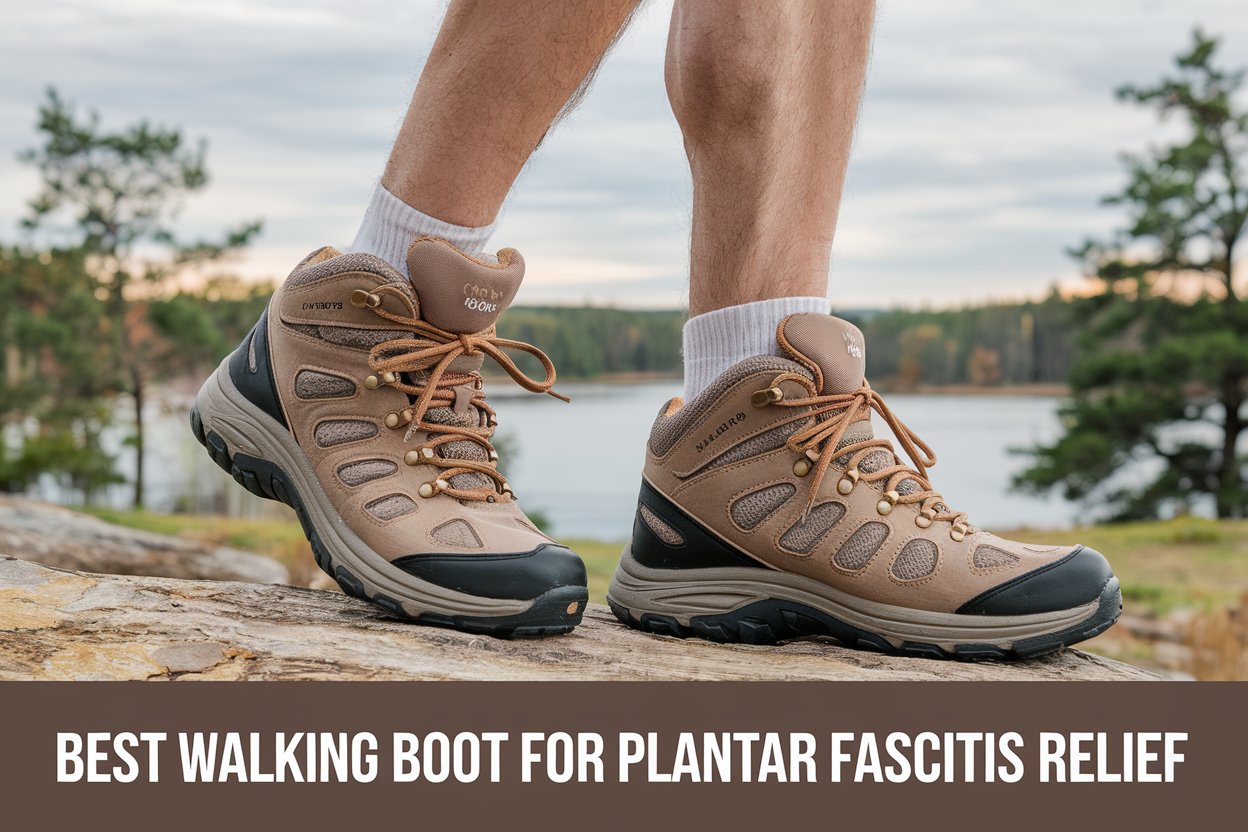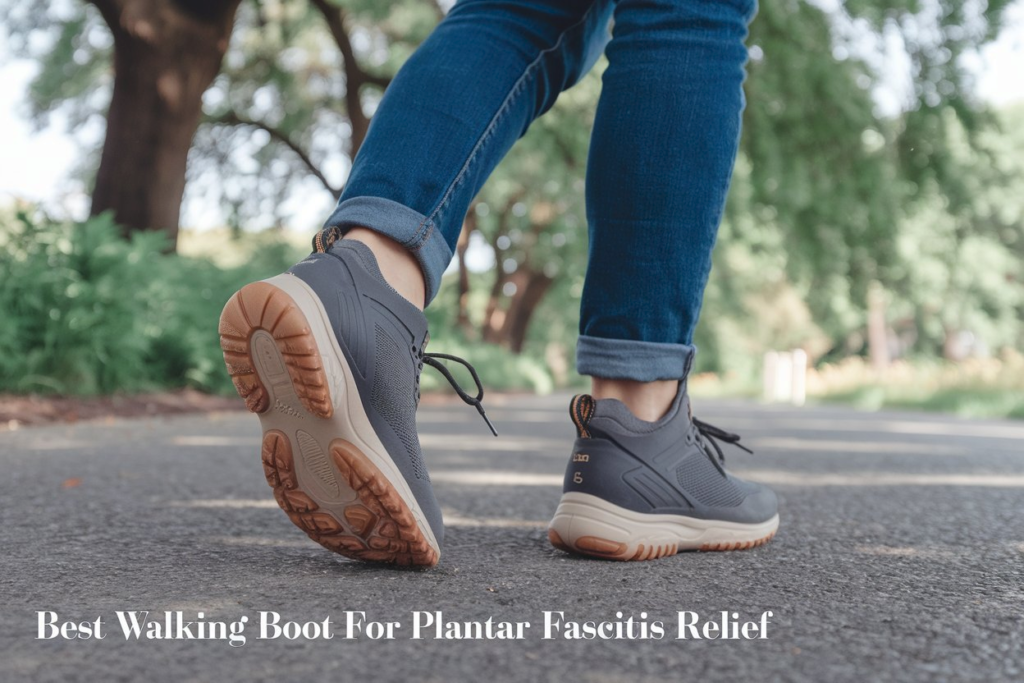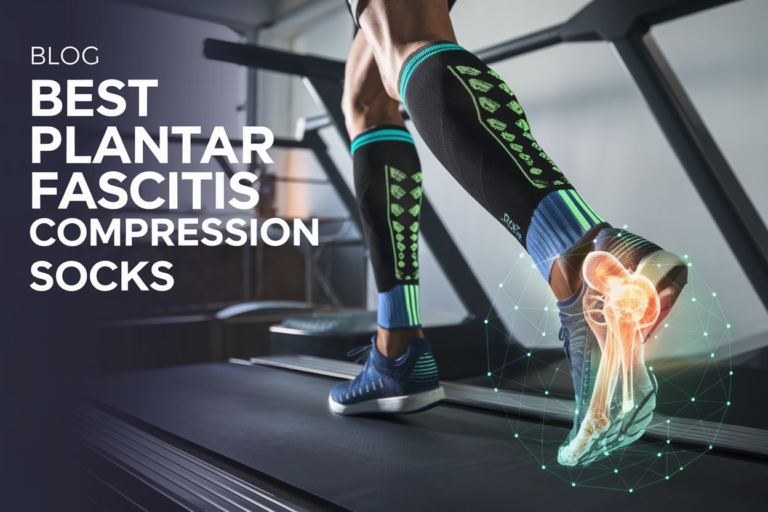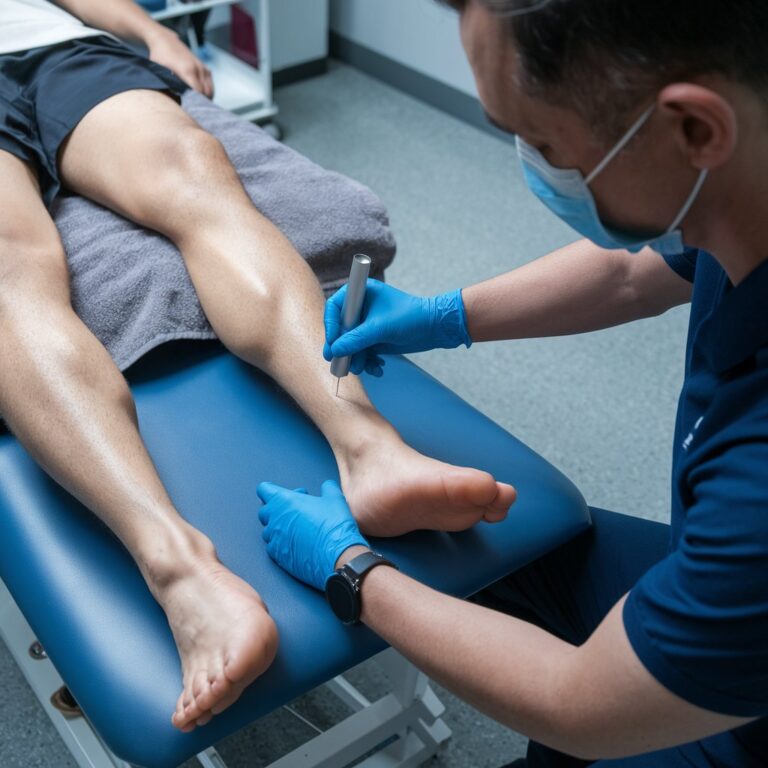Best Walking Boot for Plantar Fasciitis Relief

Imagine a busy day on your feet, juggling tasks while trying to make the most of every moment. Now, picture the familiar ache starting, spreading from your heel with each step. This is a common issue for many, especially those with plantar fasciitis.
The search for relief becomes a mission as life goes on. People look for supportive footwear options. That’s where specialized walking boots come in. With many choices, from budget-friendly to premium, finding the best walking boot for plantar fasciitis can seem daunting. But don’t worry; this guide will help you through the options, ensuring you find the right comfort and support.
With nearly a thousand user reviews, we’re here to guide you to relief. These reviews cover various price points, helping you make an informed choice.
Table of Contents
Understanding Plantar Fasciitis
Plantar fasciitis is a common issue for people who are active. It happens when the plantar fascia, a tissue band from the heel to the toes, gets inflamed. Knowing about this condition helps spot its signs and find the main causes.
What is Plantar Fasciitis?
It’s a top reason for heel and foot pain. The pain is sharp and usually hits near the heel or arch. It’s worse after resting a lot or when you first step out of bed. Learning about plantar fasciitis helps you deal with the pain better.
Symptoms and Causes of Plantar Fasciitis
Knowing the signs of plantar fasciitis is key to acting fast. Common signs include:
- Pain near the heel
- Arch pain
- Swelling on the bottom of the heel
Things that can lead to plantar fasciitis include:
- Rapidly starting new sports or exercise programs
- Prolonged standing on hard surfaces
- Wearing shoes without enough cushioning or support
- Having flat feet or high arches
- Being overweight
- Tight calf muscles
- Being between the ages of 40 and 60 years
Dealing with these causes can help in treating plantar fasciitis. Recovery can take time, often helped by supportive shoes and physical therapy. Understanding these points is crucial for managing and beating this common foot problem.
Importance of Supportive Footwear

Wearing the right shoes is key to easing plantar fasciitis pain. Many people don’t realize how crucial shoe choice is. Knowing what makes shoes supportive helps you pick the best ones for healing and comfort.
Why Support Matters for Plantar Fasciitis
Support is vital for those with plantar fasciitis. Studies show 83.2% of those with the condition wear the wrong shoes, making pain worse. Shoes without enough support can cause more heel pain and limit what you can do.
Supportive shoes help keep your foot in a natural position. This reduces pain and lowers the chance of getting hurt again.
Common Features of Supportive Shoes and Boots
Supportive shoes have key features that help with plantar fasciitis:
- Arch Support: Keeps your foot aligned and spreads out pressure.
- Cushioning: Soaks up shock and makes walking more comfortable.
- Thick Soles: Gives extra stability and protection from hard floors.
- Limited Heel Height: The right heel height, between 0.5-4 cm, lessens plantar fascia stress.
- Responsive Soles: Allows for flexibility and adaptability on different surfaces.
Adding these features to your shoes can make a big difference. It can improve comfort and support, making life better for those with plantar fasciitis.
Best Walking Boot for Plantar Fasciitis
Finding the best walking boot for plantar fasciitis means looking at several key factors. The fit is very important. A boot that’s too tight or too loose can make the pain worse. It’s important to choose a boot that fits just right.
Arch support is also key in easing the pain in your plantar fascia. So, make sure the boot you pick has good arch support. The level of cushioning affects how comfortable the boot is. And, the materials should be durable yet breathable to keep your feet cool.
Looking at different walking boot options will help you find the perfect one for you.
Criteria for Choosing the Right Boot
- Fit: Ensure a snug fit without excessive tightness.
- Arch Support: Look for boots that provide ample support to reduce strain.
- Cushioning: Choose a boot that has good padding for comfort during use.
- Material: Opt for breathable materials that promote comfort and durability.
Top Brands to Consider
When looking for a plantar fasciitis boot, some brands are worth checking out. BraceAbility is known for its quality and support for the arch. Aircast is great for cushioning and stability. Comparing these brands can help you find the best walking boot for your needs.
| Brand | Best Features | Price Range |
|---|---|---|
| BraceAbility | High-quality construction, arch support | $60 – $175 |
| Aircast | Superior cushioning, stability | $70 – $200 |
| Other Brands | Diversified options, various styles | Varies depending on features |
Benefits of a Walking Boot for Plantar Fasciitis
A walking boot is a big help for people with plantar fasciitis. It offers comfort and pain relief and helps with plantar fasciitis recovery. Let’s look at how these boots can make healing easier.

Improved Comfort and Pain Relief
Walking boots are made to keep the foot stable. This reduces strain on the plantar fascia. People find this comfort and pain relief very helpful, especially when doing everyday tasks. The boot also lowers pressure on the sore area, making it easier to move.
Enhanced Recovery and Stability
With a walking boot, you can still move around while your injury heals. This balance helps with better healing and supports plantar fasciitis recovery. The boot keeps your foot in the right position, preventing more injury.
| Benefit | Description |
|---|---|
| Comfort | Designed to cushion the foot, providing relief from pain. |
| Stability | Helps maintain foot alignment and reduces strain on the plantar fascia. |
| Mobility | Allows for a degree of movement while protecting the injured area. |
| Healing | Promotes recovery by allowing safe movement and reducing pain during rehabilitation. |
For those feeling anxious during recovery, using apps for therapy can be a big help. These apps offer support and mindfulness. They work well with walking boots to help with complete recovery.
Night Splints vs. Walking Boots
Night splints and walking boots are key in treating plantar fasciitis. They have different uses. Knowing the differences can make a big difference in how well they work and how comfortable they are. Let’s look at what makes these two options unique.
Key Differences Explained
Night splints keep the foot slightly bent while you sleep. This helps keep the plantar fascia and Achilles tendon stretched. It reduces pain in the morning from plantar fasciitis. Walking boots, however, support and keep the foot still during the day. They are great for severe cases that don’t get better with other treatments.
| Feature | Night Splints | Walking Boots |
|---|---|---|
| Purpose | Maintain foot flexion overnight | Support during walking and activities |
| Use | Nighttime use | Daytime use |
| Comfort | May cause discomfort if improperly fitted | Designed for stability and pain relief |
| Effectiveness | Varies by individual | Most effective for severe cases |
When to Use Each Type
Knowing when to use night splints or walking boots is key for treating plantar fasciitis. Use night splints if you have a lot of heel pain in the morning. They help stretch important muscles and lessen pain.
Walking boots are best during the day for those with severe symptoms. They work well when other treatments don’t help. Adding orthotic inserts made for plantar fasciitis can also help by supporting the arch and keeping it at the right height. Choosing the best option depends on how you feel and how well you respond to treatment.
How to Properly Use a Walking Boot for Plantar Fasciitis
Learning how to use a walking boot right can make a big difference in comfort and healing from plantar fasciitis. This part talks about how to adjust the boot and the best schedule for wearing it.
Adjusting for Comfort
For a good fit that’s also comfy, it’s key to adjust the walking boot straps. Start by loosening the straps and taking a few steps. Then, tighten each strap bit by bit until you feel secure but still comfortable. Make sure the pressure on your foot isn’t too much, as it can cut off blood flow or cause pain.
Wearing Schedule and Duration
Having a good schedule for wearing boots is vital for healing. Orthopedic boots are usually worn for 1 to 6 weeks, based on how bad the injury is. Start with short periods of wearing the boot and slowly increase the time as you get more comfortable. It’s important to balance wearing the boot with resting your foot to lessen swelling and help healing. Always keep the injured leg up when you’re resting to ease pressure and swelling.
| Wearing Schedule | Comments |
|---|---|
| First Few Days | Wear the boot as recommended, focusing on short durations to gauge comfort. |
| Week 1 | Increase time while monitoring for any discomfort; aim for at least 4-6 hours daily. |
| Week 2 | Continue to adjust the duration, adding mobility exercises as tolerated. |
| Week 3 Onwards | Gradually reintroduce normal footwear based on comfort and doctor’s advice. |
Following this method keeps your foot working right. Using the walking boot correctly, by adjusting it and wearing it on a schedule, creates a good healing space for plantar fasciitis.
Alternative Treatments for Plantar Fasciitis
Looking into other ways to treat plantar fasciitis can really help with healing and less pain. Options like physical therapy and massage can be very helpful. They focus on easing symptoms and helping the body heal. This lets people move better and feel more comfortable.
Physical Therapy and Exercises
Physical therapy is key in treating plantar fasciitis. It includes special stretches and exercises for the foot and calf muscles. These help make the foot more flexible and lessen the strain on the plantar fascia. Therapists might also use ultrasound therapy and taping for extra support.
Going to physical therapy regularly can really make a difference. Many people see better results from doing it often.
Massage Techniques for Relief
Massage is another good way to help with plantar fasciitis. It helps increase blood flow and eases pain by focusing on the plantar fascia and nearby areas. Different massage types, like deep tissue or foam rolling, target specific areas to relieve tension.
Having regular massages can help you relax and aid in healing. Adding massage to your treatment plan can be very beneficial.
Plantar Fasciitis Walking Boot Features to Look For
Choosing the right boots for plantar fasciitis can make a big difference in comfort and pain relief. Look for key features like good arch support and the right weight and material. These elements greatly affect your walking comfort.
Arch Support and Cushioning
Arch support is crucial in a walking boot. It spreads your weight evenly, easing pain in the heel. Boots with special cushioning systems are great for absorbing shock and making each step more comfortable. The Ortho-Cushion system is a top choice for plantar fasciitis relief.
Weight and Material Considerations
The boot’s weight affects how comfortable it is to wear. Lighter boots make moving easier and let you wear them longer without getting tired. Look for materials like leather, nylon, and synthetic fabrics that are strong yet light. Finding the right balance between support and weight makes walking more enjoyable.
| Boot Brand | Arch Support | Cushioning | Weight | Material |
|---|---|---|---|---|
| Delta Women’s Hiking Boots | Excellent | Highly Effective | Lightweight | Synthetic and Mesh |
| Keen’s Targhee III Mid | Good | Good | Moderate | Leather and Mesh |
| Salomon’s X Ultra 4 Mid GTX | Very Good | Excellent | Lightweight | GORE-TEX and Synthetic |
| Columbia’s Newton Ridge Plus | Good | Moderate | Lightweight | Leather and Mesh |
| Merrell’s Moab 3 Mid | Excellent | Excellent | Lightweight | Suede and Mesh |
Women’s Walking Boot for Plantar Fasciitis
Women looking for relief from plantar fasciitis can find comfort in special walking boots made just for them. These boots fit the unique shape of a woman’s foot well. They help ease the pain of plantar fasciitis and look good too.
They often have adjustable straps, deep heel cups, and strong arch support. Brands like Vionic, New Balance, and Hoka One One offer boots designed for women. You can also find shoes with a rocker sole for more comfort.
- Price Range: Women’s walking boots for plantar fasciitis usually cost between $9.99 and $34.99, making them affordable.
- Customer Ratings: Reviews range from 5 to 295, showing different levels of customer satisfaction.
- Available Sizes: Sizes go from 5 to 12, fitting many foot sizes.
When looking at women’s options for plantar fasciitis, check the overall ratings. A top choice has a 4.9 out of 5 rating, showing customers are very happy. Some brands focus on durability with special materials for long-lasting comfort.
| Boot Type | Overall Rating | Price Range | Available Sizes |
|---|---|---|---|
| Best Overall | 4.8 | $9.99 – $34.99 | 5 – 11 |
| Best Waterproof | 4.9 | $9.99 – $34.99 | 5 – 11 |
| Best Budget | 4.9 | $9.99 – $34.99 | 5 – 12 |
| Most Durable | 5.0 | $9.99 – $34.99 | 7 – 14 |
| Best for Hiking | 4.7 | $9.99 – $34.99 | 7 – 13 |
Choosing the right women’s walking boot for plantar fasciitis can really help with comfort and healing. With fashion and function together, women don’t have to give up style for foot health.
Plantar Fasciitis Walking Boot Men
Finding the right footwear is key for men with plantar fasciitis. The right boots offer comfort and support for male feet. There are many options, so picking boots made for heel pain is important for staying active.
Popular Options for Men
Many brands offer great boots for men with plantar fasciitis. Aircast and BraceAbility are known for their strong build and good arch support. These boots cost between $9.99 to $34.99, making them affordable for many.
Some key features make these boots stand out:
- Many have a clamshell design for better support.
- Boots that work as slippers are great for resting.
- They have high-density polyethylene shells for stiffness and soft padding.
- Reviews show a lot of satisfaction, with up to 295 reviews.
A huge 83.2% of people with plantar fasciitis wear the wrong shoes. Wearing supportive shoes is crucial. Many men find these boots essential for getting better, and boots like Grisport Quatro Boots offer comfort for walking. Doctors can help pick the right boots for safety and effectiveness. With the right care, these boots help reduce pain and encourage staying active.
Maintaining Your Walking Boot for Longevity
Keeping your walking boot in good shape is key to handling plantar fasciitis. It’s important to clean and care for your boot regularly. By following the right cleaning tips, you can keep your boots looking great and lasting longer.
Cleaning and Care Tips
Here are some tips to keep your walking boot in top condition:
- Regular cleaning: Use mild soap and a soft cloth to clean your boots. Avoid harsh chemicals that can damage materials.
- Drying: After cleaning, let your boots dry completely. This helps prevent mildew and keeps the boot’s shape.
- Conditioning: For leather boots, use a conditioner now and then. It keeps the material soft and stops cracks.
- Proper storage: Keep your boots in a cool, dry spot, away from sunlight. This reduces wear and tear.
- Regular inspections: Look for any damage and fix it quickly to make your boots last longer.
Following these steps can really help keep your walking boot in great shape. It will stay comfy and work well for you. Remember, taking good care of your shoes is a big part of looking after your health, as explained in guidelines about managing foot health.
| Maintenance Task | Frequency | Purpose |
|---|---|---|
| Cleaning | After each use | Remove dirt and bacteria, improve appearance |
| Conditioning (Leather) | Every few months | Prevent cracking, maintain flexibility |
| Inspection for Damage | Monthly | Identify and repair issues early |
| Drying | After cleaning or exposure to moisture | Prevent mildew and maintain shape |
| Proper Storage | Always | Protect from deformities and prolonged damage |
Customer Reviews and Feedback on Walking Boots
Customer reviews can greatly help you pick the right walking boots for plantar fasciitis. They show which boots work best and let you see the good and bad sides. People share their thoughts on comfort, support, and how well the boots help with pain.
What Users are Saying
Many users are happy with walking boots made for plantar fasciitis. Boots like the Kuru Chicane have made walking pain-free for them. One user, who had plantar fasciitis for 15 years, found relief with the Kuru Chicane after trying many other shoes.
They enjoyed two pain-free days with the Kuru Chicane and plan to buy more.
Common Praise and Complaints
Reviews often praise these boots for several reasons:
- Comfort during long wear.
- Good arch support that helps with heel pressure.
- They are lightweight and don’t feel heavy even on long walks.
But, there are also some common complaints:
- Sizing issues that buyers should think about before buying.
- Some worry about the durability, especially in cheaper models.
- Some find the boots uncomfortable at first but get used to them.
Reviews give buyers a clear view of what to expect. By looking at the good points and the problems others faced, you can make a better choice.
| Walking Boot | Type | Price | Notable Features |
|---|---|---|---|
| Kuru Chicane | Comfort Boot | $139 | Pain relief, arch support, stylish design |
| Hoka Kaha 2 | Best Overall | $160 | Maximum cushioning, excellent grip |
| Keen Targhee II Mid | Runner-Up | $150 | Waterproof, rugged traction |
| Columbia Newton Ridge Plus | Best Budget | $110 | Affordable, lightweight |
| Merrell Bravada 2 | Best Hiking Shoe | $130 | Trail-ready, breathable |
| Kuru Quest | Best for Easy Trails | $119 | Comfortable, supportive |
Seeking Professional Guidance
Plantar fasciitis is a common issue that causes heel pain and swelling of the plantar fascia. Many people can handle it at home, but seeing a podiatrist is key if it doesn’t get better. They can give you advice on shoes and walking boots that offer the right support.
If you’re still in pain, swelling, or finding it hard to move, get medical help. A podiatrist can look at your feet and help pick the best walking boot for you. Their advice can make you more comfortable and help you stay active.
Your podiatrist might also recommend other treatments like physical therapy, custom orthotics, or exercises. These can help with flexibility and strength. Working with a professional is important for managing plantar fasciitis well.
FAQ
What is a walking boot for plantar fasciitis?
How do I know if I need a plantar fasciitis walking boot?
What features should I look for in the best walking boot for plantar fasciitis?
Can I wear a walking boot for plantar fasciitis all day?
Are there specific walking boots designed for men and women with plantar fasciitis?
How do walking boots differ from night splints for plantar fasciitis?
How can I maintain my plantar fasciitis boot for longevity?
Where can I find customer reviews on walking boots for plantar fasciitis?
When should I seek professional guidance for plantar fasciitis?







